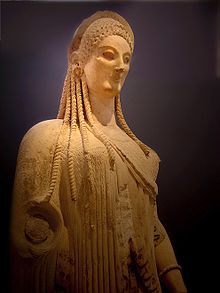
Back النساء في أعياد الثيسموفوريا (مسرحية) Arabic Les tesmofòries Catalan Die Thesmophoriazusen German Θεσμοφοριάζουσες (κωμωδία) Greek Las Tesmoforiantes Spanish Naistenjuhla Finnish Les Thesmophories French חג הנשים (קומדיה יוונית) HE Konur á Þesmófóruhátíð Icelandic Le donne alle Tesmoforie Italian
| Thesmophoriazusae | |
|---|---|
 | |
| Written by | Aristophanes |
| Chorus | 1) Agathon's chorus 2) Women of Athens |
| Characters |
|
| Setting | 1) Street outside Agathon's house 2) Forecourt of the Temple of Demeter Thesmophoros |
Thesmophoriazusae (Greek: Θεσμοφοριάζουσαι; Thesmophoriazousai, lit. 'women celebrating the festival of the Thesmophoria'), or Women at the Thesmophoria (sometimes also called The Poet and the Women), is one of eleven surviving comedy plays by Aristophanes. It was first produced in 411 BC, probably at the City Dionysia. The play's focuses include the subversive role of women in a male-dominated society; the vanity of contemporary poets, such as the tragic playwrights Euripides and Agathon; and the shameless, enterprising vulgarity of an ordinary Athenian, as represented in this play by the protagonist, Mnesilochus. The work is also notable for Aristophanes' free adaptation of key structural elements of Old Comedy and for the absence of the anti-populist and anti-war comments that pepper his earlier work.[3] It was produced in the same year as Lysistrata, another play with sexual themes.
How Thesmophoriazusae fared in the City Dionysia drama competition is unknown, but the play has been considered one of Aristophanes' most brilliant parodies of Athenian society.[3]

- ^ Aristophanes: Lysistrata, The Acharnians, The Clouds Alan Sommerstein, Penguin Classics 1973, p. 37
- ^ Aristophanes: The Frogs and Other Plays David Barrett (ed), Penguin Classics 1964
- ^ a b Barrett, David, ed. (1964). Aristophanes: The Frogs and Other Plays. Penguin Books. p. 97. ISBN 0140441522.
- ^ "Digital LIMC". weblimc.org. Retrieved 2024-04-21.
© MMXXIII Rich X Search. We shall prevail. All rights reserved. Rich X Search